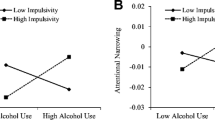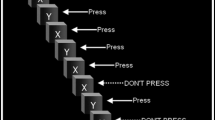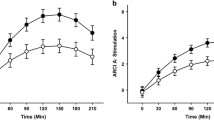Abstract
Rationale
A rich literature suggests that both impulsiveness and drug-induced euphoria are risk factors for drug abuse. However, few studies have examined whether sensitivity to the euphoric effects of stimulants is related to attention lapses, a behavioral measure of inattention sometimes associated with impulsivity.
Objective
The aim of the study was to examine ratings of d-amphetamine drug liking among individuals with high, moderate, and low attention lapses.
Methods
Ninety-nine healthy volunteers were divided into three equal-sized groups based on their performance on a measure of lapses of attention. The groups, who exhibited low, medium, and high attention lapses (i.e., long reaction times) on a simple reaction time task, were compared on their subjective responses (i.e., ratings of liking and wanting more drug) after acute doses of d-amphetamine (0, 5, 10, and 20 mg).
Results
Subjects who exhibited high lapses liked 20 mg d-amphetamine less than subjects who exhibited low lapses. These subjects also tended to report smaller increases in “wanting more drug” after d-amphetamine.
Conclusion
The findings suggest that participants who exhibit impaired attention may be less sensitive to stimulant-induced euphoria.

Similar content being viewed by others
References
APA (1994) Diagnostic and statistical manual of mental disorders, 4th edn. American Psychiatric Association, Washington, D.C
Arns M, de Ridder S, Strehl U, Breteler M, Coenen A (2009) Efficacy of neurofeedback treatment in ADHD: the effects on inattention, impulsivity and hyperactivity: a meta-analysis. Clin EEG Neurosci 40:180–189
Baler RD, Volkow ND (2006) Drug addiction: the neurobiology of disrupted self-control. Trends Mol Med 12:559–566
Belin D, Mar AC, Dalley JW, Robbins TW, Everitt BJ (2008) High impulsivity predicts the switch to compulsive cocaine-taking. Science 320:1352–1355
Blum K, Braverman ER, Holder JM, Lubar JF, Monastra VJ, Miller D et al (2000) Reward deficiency syndrome: a biogenetic model for the diagnosis and treatment of impulsive, addictive, and compulsive behaviors. J Psychoactive Drugs 32(Suppl: i–iv):1–112
Castellanos FX, Tannock R (2002) Neuroscience of attention-deficit/hyperactivity disorder: the search for endophenotypes. Nat Rev Neurosci 3:617–628
Castellanos FX, Sonuga-Barke EJ, Milham MP, Tannock R (2006) Characterizing cognition in ADHD: beyond executive dysfunction. Trends Cogn Sci 10:117–123
Conners CK (2002) Forty years of methylphenidate treatment in attention-deficit/hyperactivity disorder. J Atten Disord 6(Suppl 1):S17–S30
de Wit H (2009) Impulsivity as a determinant and consequence of drug use: a review of underlying processes. Addict Biol 14:22–31
de Wit H, Phan KL (2009) Positive reinforcement theories of drug use. In: Kassel JD (ed) Substance abuse and emotion. American Psychological Association, Washington, D.C
Wade TR, de Wit H, Richards JB (2000) Effects of dopaminergic drugs on delayed reward as a measure of impulsive behavior in rats. Psychopharmacology (Berl) 150:90–101
de Wit H, Richards JB (2004) Dual determinants of drug abuse: reward and impulsivity. In: Bevins RA, Bardo MT (eds) Nebraska symposium on motivation. University of Nebraska Press, Nebraska, pp 19–55
de Wit H, Pierri J, Johanson CE (1989) Reinforcing and subjective effects of diazepam in nondrug-abusing volunteers. Pharmacol Biochem Behav 33:205–213
de Wit H, Crean J, Richards JB (2000) Effects of d-amphetamine and ethanol on a measure of behavioral inhibition in humans. Behav Neurosci 114:830–837
de Wit H, Enggasser JL, Richards JB (2002) Acute administration of d-amphetamine decreases impulsivity in healthy volunteers. Neuropsychopharmacology 27:813–825
Everitt BJ, Belin D, Economidou D, Pelloux Y, Dalley JW, Robbins TW (2008) Review. Neural mechanisms underlying the vulnerability to develop compulsive drug-seeking habits and addiction. Philos Trans R Soc Lond B Biol Sci 363:3125–3135
Gambin M, Swiecicka M (2009) Relation between response inhibition and symptoms of inattention and hyperactivity–impulsivity in children. Br J Clin Psychol 48:425–430
Gevensleben H, Holl B, Albrecht B, Vogel C, Schlamp D, Kratz O et al (2009) Is neurofeedback an efficacious treatment for ADHD? A randomised controlled clinical trial. J Child Psychol Psychiatry Allied Discipl 50:780–789
Girden ER (1992) ANOVA repeated measures, vol 84. Sage, Newbury Park
Greenhill L, Beyer DH, Finkleson J, Shaffer D, Biederman J, Conners CK et al (2002) Guidelines and algorithms for the use of methylphenidate in children with attention-deficit/hyperactivity disorder. J Atten Disord 6(Suppl 1):S89–S100
Hausknecht KA, Acheson A, Farrar AM, Kieres AK, Shen RY, Richards JB et al (2005) Prenatal alcohol exposure causes attention deficits in male rats. Behav Neurosci 119:302–310
Iacono WG, Malone SM, McGue M (2008) Behavioral disinhibition and the development of early-onset addiction: common and specific influences. Annu Rev Clin Psychol 4:325–348
Koob GF, Bloom FE (1988) Cellular and molecular mechanisms of drug dependence. Science 242:715–723
Leth-Steensen C, Elbaz Z, Douglas V (2000) Mean response times, variability and skew in the responding of ADHD children: a response time distributional approach. Acta Psychol (Amst) 104:167–190
Leyton M, aan het Rot M, Booij L, Baker GB, Young SN, Benkelfat C (2007) Mood-elevating effects of d-amphetamine and incentive salience: the effect of acute dopamine precursor depletion. J Psychiatry Neurosci 32:129–136
Lott DC, Kim SJ, Cook EH Jr, de Wit H (2005) Dopamine transporter gene associated with diminished subjective response to amphetamine. Neuropsychopharmacology 30:602–609
McNair D, Lorr M, Droppleman L (1971) Manual for the profile of mood states (manual). Educational and Industrial Service, San Diego
Munro CA, McCaul ME, Oswald LM, Wong DF, Zhou Y, Brasic J et al (2006) Striatal dopamine release and family history of alcoholism. Alcohol Clin Exp Res 30:1143–1151
Oswald LM, Wong DF, McCaul M, Zhou Y, Kuwabara H, Choi L et al (2005) Relationships among ventral striatal dopamine release, cortisol secretion, and subjective responses to amphetamine. Neuropsychopharmacology 30:821–832
Oswald LM, Wong DF, Zhou Y, Kumar A, Brasic J, Alexander M et al (2007) Impulsivity and chronic stress are associated with amphetamine-induced striatal dopamine release. Neuroimage 36:153–166
Patrick CJ, Curtin JJ, Tellegen A (2002) Development and validation of a brief form of the multidimensional personality questionnaire. Psychol Assess 14:150–163
Patton JH, Stanford MS, Barratt ES (1995) Factor structure of the Barratt impulsiveness scale. J Clin Psychol 51:768–774
Perry JL, Nelson SE, Carroll ME (2008) Impulsive choice as a predictor of acquisition of IV cocaine self- administration and reinstatement of cocaine-seeking behavior in male and female rats. Exp Clin Psychopharmacol 16:165–177
Poulos CX, Parker JL, Le DA (1998) Increased impulsivity after injected alcohol predicts later alcohol consumption in rats: evidence for “loss-of-control drinking” and marked individual differences. Behav Neurosci 112:1247–1257
Reeves DL, Bleiberg J, Roebuck-Spencer T, Cernich AN, Schwab K, Ivins B et al (2006) Reference values for performance on the automated neuropsychological assessment metrics V3.0 in an active duty military sample. Mil Med 171:982–994
Reynolds B, Ortengren A, Richards JB, de Wit H (2006) Dimensions of impulsive behavior: personality and behavioral measures. Pers Individ Differ 40:305–315
Rosa-Neto P, Lou HC, Cumming P, Pryds O, Karrebaek H, Lunding J et al (2005) Methylphenidate-evoked changes in striatal dopamine correlate with inattention and impulsivity in adolescents with attention deficit hyperactivity disorder. Neuroimage 25:868–876
Scheres A, Milham MP, Knutson B, Castellanos FX (2007) Ventral striatal hyporesponsiveness during reward anticipation in attention-deficit/hyperactivity disorder. Biol Psychiatry 61:720–724
Simmonds DJ, Fotedar SG, Suskauer SJ, Pekar JJ, Denckla MB, Mostofsky SH (2007) Functional brain correlates of response time variability in children. Neuropsychologia 45:2147–2157
Spencer TJ, Wilens TE, Biederman J, Weisler RH, Read SC, Pratt R (2006) Efficacy and safety of mixed amphetamine salts extended release (Adderall XR) in the management of attention-deficit/hyperactivity disorder in adolescent patients: a 4-week, randomized, double-blind, placebo-controlled, parallel-group study. Clin Ther 28:266–279
Spencer SV, Hawk LW Jr, Richards JB, Shiels K, Pelham WE Jr, Waxmonsky JG (2009) Stimulant treatment reduces lapses in attention among children with ADHD: the effects of methylphenidate on intra-individual response time distributions. J Abnorm Child Psychol 37:805–816
Tarter RE, Kirisci L, Mezzich A, Cornelius JR, Pajer K, Vanyukov M et al (2003) Neurobehavioral disinhibition in childhood predicts early age at onset of substance use disorder. Am J Psychiatry 160:1078–1085
van Gaalen MM, van Koten R, Schoffelmeer AN, Vanderschuren LJ (2006) Critical involvement of dopaminergic neurotransmission in impulsive decision making. Biol Psychiatry 60:66–73
Ventura R, Cabib S, Alcaro A, Orsini C, Puglisi-Allegra S (2003) Norepinephrine in the prefrontal cortex is critical for amphetamine-induced reward and mesoaccumbens dopamine release. J Neurosci 23:1879–1885
Walderhaug E, Lunde H, Nordvik JE, Landro NI, Refsum H, Magnusson A (2002) Lowering of serotonin by rapid tryptophan depletion increases impulsiveness in normal individuals. Psychopharmacology (Berl) 164:385–391
White TL, Justice AJ, de Wit H (2002) Differential subjective effects of D-amphetamine by gender, hormone levels and menstrual cycle phase. Pharmacol Biochem Behav 73:729–741
Acknowledgments
The authors thank Margo Meverden and Adam Strohm for their technical contributions.
Author information
Authors and Affiliations
Corresponding author
Additional information
This study was supported in part by the National Institute of Drug Abuse grants DA02812, DA09133, and DA021336.
Rights and permissions
About this article
Cite this article
McCloskey, M., Palmer, A.A. & de Wit, H. Are attention lapses related to d-amphetamine liking?. Psychopharmacology 208, 201–209 (2010). https://doi.org/10.1007/s00213-009-1719-9
Received:
Accepted:
Published:
Issue Date:
DOI: https://doi.org/10.1007/s00213-009-1719-9




